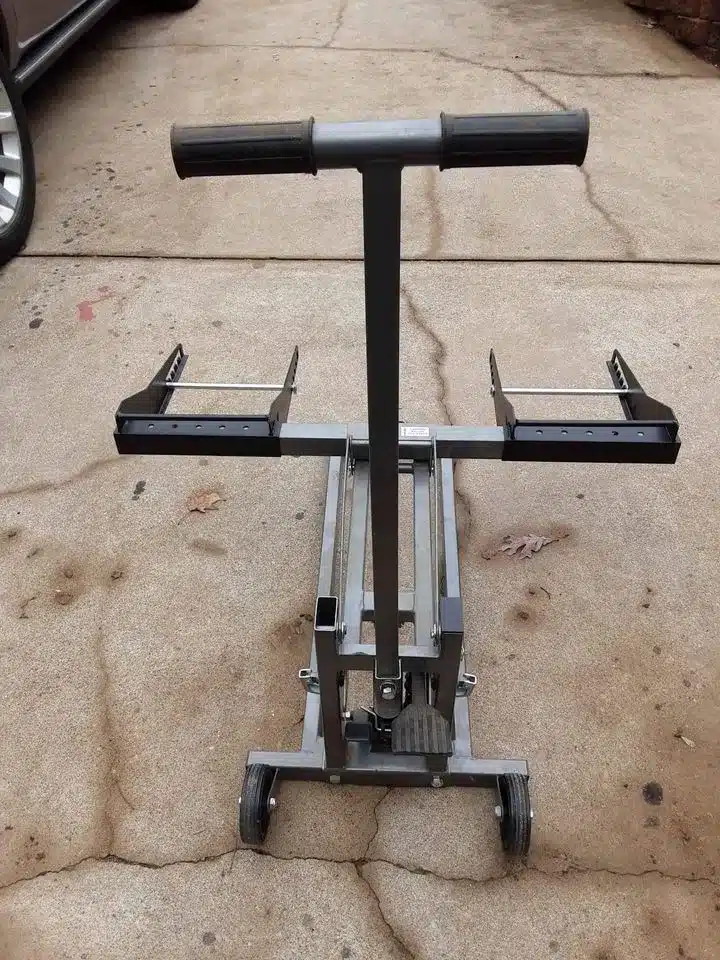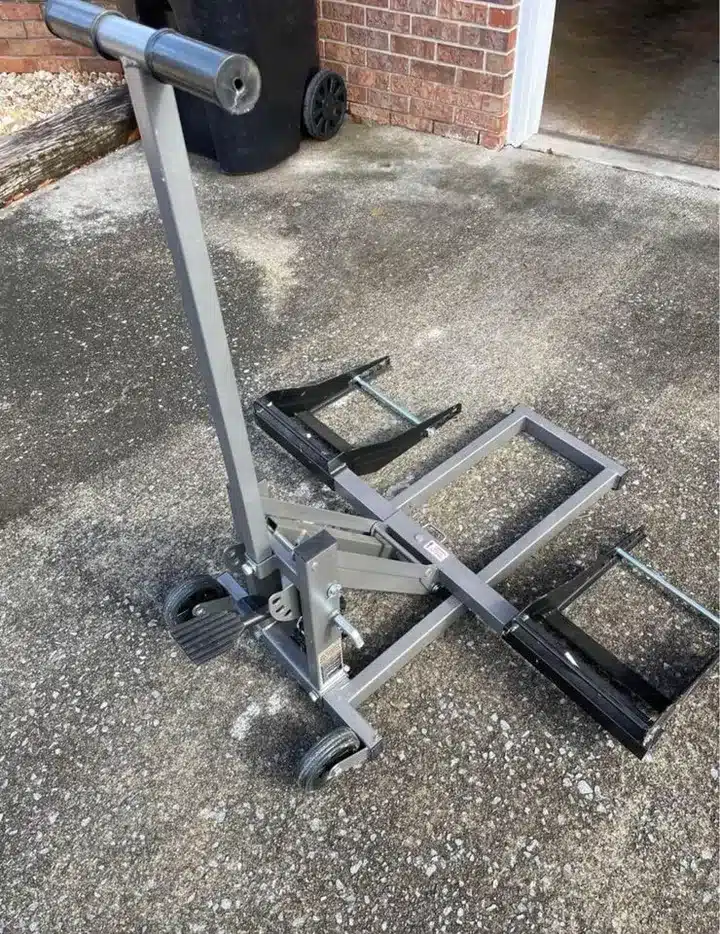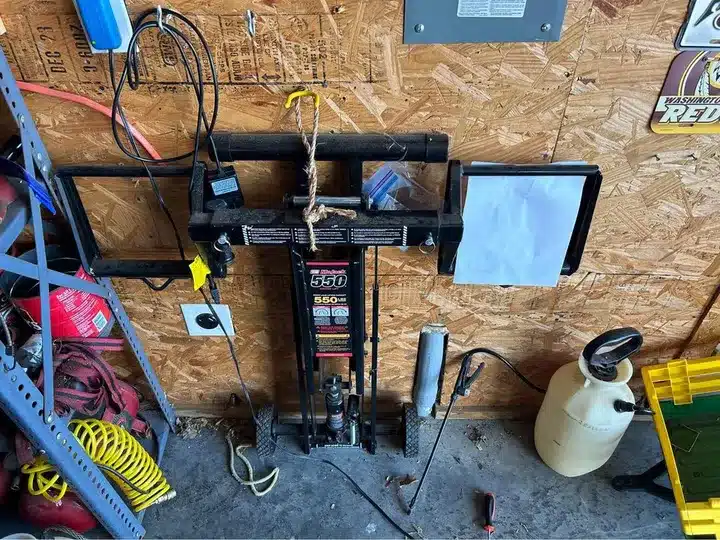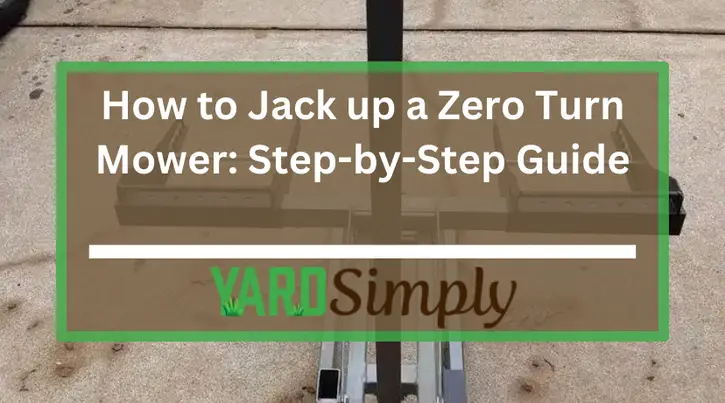As an experienced landscaper with years of hands-on maintenance expertise, I can attest to the importance of correctly jacking up a zero turn mower. Safety and precision are paramount, and I’m here to guide you through the process.
This article will provide you with a straightforward, authoritative approach to lifting your mower, ensuring your safety and the longevity of your equipment.
Trust in my practical advice and let’s get your mower ready for efficient, trouble-free operation.
Quick Summary
- Properly jacking up a zero turn mower involves using the right jack and securing the mower on a flat surface to ensure safety and equipment longevity.
- Essential tools for this task include a hydraulic or car jack, socket wrench set, and protective gear like gloves and safety glasses.
- A 2018 report by the Consumer Product Safety Commission estimated over 6,394 injuries related to lawn mower incidents required emergency room visits.
- In my opinion, the effort to correctly lift the mower is well worth it for the ease of maintenance and the protection it provides to both the operator and the mower.
How to Jack Up a Zero Turn Mower
Lifting a zero turn mower safely and efficiently is crucial for maintenance and repair tasks. This quick guide outlines the essential steps to jack up your mower correctly, ensuring both your safety and the protection of your equipment.
Follow these simple steps to elevate your mower with confidence and ease.
- Gather Tools: Obtain a suitable hydraulic or car jack, socket wrench set, and protective gear (gloves, safety glasses).
- Park Mower: Place the mower on a flat, stable surface and engage the parking brake.
- Block Tires: Use sturdy objects like wooden blocks or bricks to block the tires opposite the side you plan to lift.
- Position Jack: Slide the jack under the mower, aligning it with the manufacturer’s recommended lifting points, usually near the mower’s axle.
- Lift Mower: Slowly raise the jack, ensuring the mower ascends steadily and securely.
- Use Jack Stands: Once at the desired height, place jack stands under the mower’s frame for stability.
- Double-Check Safety: Confirm the mower is stable and securely positioned on the jack stands before performing any maintenance.
Collect The Tools
Before I begin the process of jacking up my zero turn mower, I need to gather all the necessary tools to ensure a safe and efficient lift.
First off, I’ll grab my hydraulic jack or a sturdy car jack that’s capable of handling the weight of my lawn mower. I can’t afford any slip-ups, so I’ll make sure the jack is in good working order.
Next, I’ll need a socket wrench set for any bolts that might need loosening during the process.
And let’s not forget about safety – I’m definitely suiting up in protective gear. Think gloves and safety glasses, because I’m not taking any chances with my well-being or the mower’s stability.
With my tools ready, I’m ready to finish this job.
Park The Mower
Having collected my tools, the next step is to park the mower on a flat, stable surface to ensure it won’t roll or shift while I work on it. I ensure it’s a clean area where I can easily maneuver around the zero turn mower.
Once I’ve found the perfect spot, I guide the mower to the location, being mindful of any obstacles that could interfere.
Next, I firmly apply the parking brake; this is crucial to prevent the mower from moving. I check that the wheels are securely in place and that the brakes are holding well.
It’s always better to be safe than sorry, so I give the mower a little nudge to ensure it’s not going anywhere before I start with the jacking process.
Obstruct The Tires
To ensure the mower stays put, I’m now going to block off the tires with sturdy objects. This is a crucial step before I use the jack because it prevents any potential movement of the lawnmower while it’s being lifted.
Safety is paramount, so I’ve already got my safety glasses on. The last thing I want is for the mower to roll off the jack and cause an accident.
I find something solid, like heavy wooden blocks or bricks, and place them snugly against the wheels on the opposite side of the tire I’m planning to lift.
This way, when I start jacking up the mower, I can rest assured it won’t shift or slide, and I can work on the tire securely and safely.
Learn More: Best Tire Pressure for Zero Turn Mower Revealed
Slide In The Jack

It’s crucial when dealing with heavy equipment like riding lawn mowers to avoid any tilting or wobbling.
I make sure to position the jack so that it’s centered, targeting the mower’s axle for the best balance. Most lawnmowers have specific points designed for jacking; I always consult the owner’s manual to locate these.
I don’t use just any jack, either. Car jacks are often a good fit for zero turn mowers due to their weight capacity and size. With the jack in place, I’m ready to lift the mower safely, without risking damage to the machine or injury to myself.
Raise The Jack
Having positioned the jack correctly, I now crank it up slowly, ensuring the zero turn mower rises steadily and securely. It’s vital for safe mowing maintenance that the lift is stable, as lawn mowers aren’t light.
As I pump the handle, I can hear the hydraulic fluid working within the jack, a sure sign that the mechanism is functioning properly. I keep an eye on the tires, watching for any shift that might indicate an uneven lift.
Slow and steady does it; I’m in no rush to risk my safety or the mower’s condition.
Once the mower is high enough for me to access the underside, I stop cranking. It’s now securely elevated, ready for whatever maintenance or inspection I’d planned.
Insert Jack Stands
With the mower elevated, my next step is to ensure stability by placing jack stands beneath the machine’s frame. It’s essential for the safety of both me and the zero turn mower, which is quite similar to a lawn tractor in terms of weight.
I carefully position the jack stands to handle the mower’s weight effectively. These stands aren’t just any tool; they’re critical for preventing the mower from accidentally lowering back down while I’m working underneath it.
I make sure the stands are on a solid, level surface and adjust them to the correct height. Once in place, I lower the mower onto the stands slowly, ensuring that the frame rests securely.
With the mower firmly supported, I can now work safely without worrying about stability.
Types of Jack For Lawn Mower
When lifting your zero turn mower, you’ll find several types of jacks that can get the job done.
I’ll be looking at options like the scissor action jack, which is straightforward and manual, and the drill turned jack, which uses a power drill for ease of use.
We’ll also consider pneumatic and hydraulic jacks, which offer more power for lifting heavier mowers effortlessly.
Scissor Action Jack
I’ll often reach for a scissor action jack when I’m working on a zero turn mower, as it’s compact and easy to maneuver under the machine. This type of jack is particularly suitable for lifting lawn mowers due to its straightforward design and reliability.
Unlike bulkier jacks, the scissor action jack has a simple mechanism that allows me to elevate the mower with minimal effort.
You just need to turn the screw, and the jack extends, lifting the mower steadily. It’s an ideal choice when space is tight, and precision is key.
The scissor action jack fits snugly under the zero turn mower, making it a breeze to perform maintenance tasks or clean the underside of the deck without hassle.
Drill Turned Jack
After using a scissor action jack, another tool I often turn to for lifting zero turn mowers is the drill turned jack. This type of jack offers quick and efficient lifting with the convenience of a power drill.
This type of jack is particularly handy when I’m looking for a fast and effortless way to elevate my mower.
By attaching the jack to my power drill, I can effortlessly raise the zero turn mower without the manual labor typically associated with traditional jacks. It’s a real game-changer for routine maintenance, allowing me to access the undercarriage swiftly.
The drill turned jack fits perfectly into my lawn care routine, ensuring I spend less time on setup and more on the actual task at hand.
Pneumatic Jack

A pneumatic jack, another essential tool in my lawn care arsenal, effortlessly lifts zero turn mowers with pressurized air power. This type of jack is a game-changer when I’m dealing with heavy-duty mowers that require maintenance or blade sharpening.
I simply connect it to my air compressor, and the jack raises the mower with a smooth, controlled motion.
What I love about using a pneumatic jack is its reliability and speed. Unlike manual jacks, there’s no back-breaking cranking involved. I just press a button and watch as the mower rises.
It’s vital, though, to ensure the air compressor has enough capacity to operate the jack effectively. With the right setup, lifting zero turn mowers becomes a breeze, making my lawn care tasks much more manageable.
Hydraulic Jack
Switching from pneumatic to hydraulic jacks, I’ve found that the latter offers unparalleled lifting strength for zero turn mowers with its fluid-driven mechanism.
When I’m working on a tractor-style mower, the engine demands clear access, and a hydraulic jack makes that easy. I’ll position the jack carefully, ensuring I avoid the fuel tank and other sensitive components like the spark plug.
Using a hydraulic jack, I can smoothly and steadily raise the mower, which is essential when I’m performing maintenance or repairs. This type of jack is reliable and provides a secure lift, minimizing any risk of the mower slipping or falling.
It’s become a trusty tool in my shed, perfect for the heavy lifting that zero turn mowers often require.
The Lawn Mower Jack, Things To Keep In Mind
When I’m looking at lawn mower jacks, I always check the load capacity first to ensure it can handle my mower’s weight.
The wheel span and adjustability are crucial too, as they must fit my mower’s size and allow for easy maneuvering.
And I don’t forget about the lift height and wheel pads; they’re key for a safe and stable lift.
Load Capacity Of The Jack

Before I select a lawn mower jack, I’ve got to ensure it has a load capacity that exceeds the weight of my zero turn mower to avoid any risk of collapse.
It’s crucial to treat my mower like any other vehicle when it comes to maintenance, including when lifting it for repairs or upkeep.
The jack’s load capacity isn’t just a suggestion; it’s a strict limit for safety. I always check the mower’s manual for its exact weight and then look for a jack capable of handling that weight with plenty of room to spare.
Wheel Span
I also need to consider the wheel span of my zero turn mower to ensure the jack fits properly and provides stable support. The mower’s wheel span dictates the size and type of jack required; it’s not just about lifting capacity.
I’ve got to match the jack’s width with my mower’s footprint. If I overlook this, I might end up with a jack that’s too flimsy or won’t fit between the wheels.
Moreover, I prefer a robust steel jack to handle the mower’s weight effectively. It’s important that the jack has a reliable gear mechanism and a smooth-operating valve to control the lift with precision.
A sturdy loader arm is also essential to prevent any slippage while I’m working on the mower.
Adjustability
Adjustability is crucial in a lawn mower jack. I need to ensure it can accommodate different mower heights and sizes for various maintenance tasks.
When I’m looking for a jack to hoist my zero turn mower, I’m particularly attentive to the range of adjustability it offers.
It’s not just about meeting the specs of my current mower; I’ve to think ahead about any future models I might purchase, especially since OEM parts and dimensions can vary.
A jack’s adjustability can mean the difference between a safe lift and a precarious situation. I always double-check that the jack’s lifting arm and base width can be tweaked to fit securely under my mower.
Without this flexibility, I’d be risking both my safety and the wellbeing of my equipment.
Wheel Pads
Having considered the adjustability of the jack, I also need to examine the wheel pads closely, as they’re essential for the mower’s stability during the lift.
These pads must cradle the machine securely, preventing any shifting that could lead to a dangerous topple.
When I’m positioning my zero turn mower, I ensure that the grass underneath is short and even to avoid any unevenness. The wheel pads should align with the mower’s wheels snugly, almost as if they’re hugging each nut and contour.
Moreover, the presence of a trailer hitch on my mower necessitates extra caution. I can’t have it getting in the way or bearing unintended weight. A stable lift is crucial, and it all starts with the proper use of wheel pads.
Lift Height
Beyond ensuring the wheel pads are correctly positioned, it’s crucial to consider the lift height of the jack as it directly impacts the ease and safety of maintenance tasks on my zero turn mower.
The right lift height allows me to access the undercarriage without crawling on the ground. It’s like using a winch to hoist a car onto a tow truck; you need enough clearance to work comfortably and safely.
If the jack’s too short, it’s like trying to secure a bolt with a mismatched wrench—frustrating and ineffective.
Similarly, if I owned a trailer, I’d need a hitch that matches the height of my trailer for a secure fit. The same principle applies here: matching the lift height to my maintenance needs ensures a safe and efficient job.
Lift Lock
Why should I pay close attention to the lift lock mechanism on my lawn mower jack before starting any maintenance task?
Well, it’s all about safety. My mower weighs a ton, and I can’t risk it slipping off the jack. A secure lift lock ensures that the mower won’t come crashing down when I’m underneath or when I’m adjusting something sensitive like the blades.
Especially when I transport the mower in my truck, I need to be certain that the lift lock is engaged. Those bumps on the road? Without a proper lock, they could spell disaster.
Even something as simple as water from a recent cleaning could make surfaces slippery, so a reliable lift lock on a four-wheel drive mower is critical for preventing a potential accident.
Safety Tips And Cautions
Before I jack up my zero turn mower, I always ensure the machine is on a flat, stable surface to prevent any accidental slippage or tipping.
I’ve learned that taking shortcuts when it comes to safety isn’t worth the risk. It’s not just about getting the job done; it’s about doing it safely.
One of the key safety tips and cautions I follow religiously is to check the area for any hazards like nails or wire that could puncture the tires or cause damage.
I also make sure there’s no one around, especially children or pets, who might wander into a potentially dangerous situation.
I treat my zero turn mower with the same respect as I’d an ATV or any other heavy machinery. I always engage the parking brake before I start. When I’m ready to jack it up, I do so slowly and steadily, never rushing the process.
If I’m ever unsure, I consult the mower’s manual because guessing can lead to mistakes.
And after lifting, I double-check that the mower is securely in place before I start working underneath it. It’s these little precautions that ensure I can complete the maintenance safely and get back to mowing without incident.
Our Verdict
From my experience, lifting a zero turn mower is not just a task, it’s an art that demands precision and care.
With the right jack, mindful of its load capacity and adjustability, the process becomes not just safer, but almost effortless. I’ve found that taking those extra moments to ensure everything is set up correctly pays off in a hassle-free maintenance session.
And remember, safety is key. Whether it’s checking the area for hazards or stabilizing the mower properly, these steps are vital.
So, go ahead, jack up that mower with confidence. You’ll find it’s a game-changer for keeping your lawn in pristine condition.
Frequently Asked Questions
Can i use car ramps instead of a jack to lift my zero turn mower for maintenance?
Yes, I can use car ramps instead of a jack to lift my mower. They’re stable and ideal for reaching the underside safely, making them a great alternative for routine maintenance tasks.
How do I stabilize the zero turn mower if i need to leave it jacked up overnight for repairs?
I’d place sturdy blocks or jack stands under the mower’s frame to ensure it’s stable if I need to leave it overnight. Safety’s key, so I’ll double-check that everything’s secure before walking away.
What should I do if my zero turn mower starts to slip or move while it’s jacked up?
If my mower starts to slip or move while elevated, I’ll immediately lower it to prevent accidents. I’ll then reassess the stability and ensure it’s securely propped before attempting any further maintenance.
Are there any zero turn mower models that should not be lifted using a jack due to their design or weight distribution?
I’m not aware of specific models that can’t be jacked up, but it’s crucial to consult the owner’s manual since manufacturers may advise against lifting certain heavy or uniquely designed zero-turn mowers.
How can I tell if the hydraulic jack i own is suitable for the weight of my zero turn mower, and where can i find this information?
I’ll check my hydraulic jack’s manual for the weight limit, ensuring it matches my mower’s specs, which I can usually find on the manufacturer’s website or in the owner’s manual.


